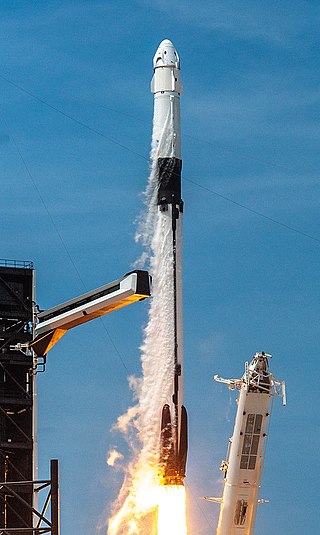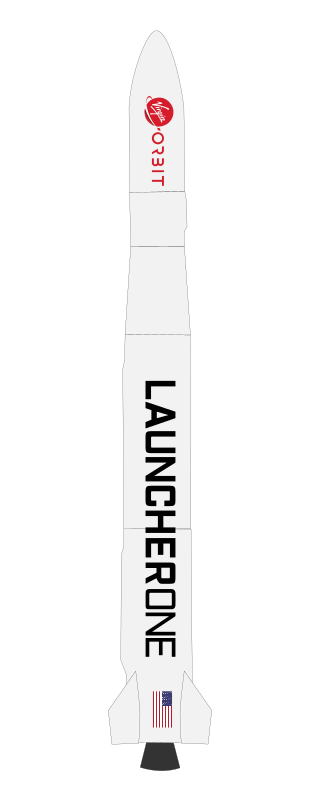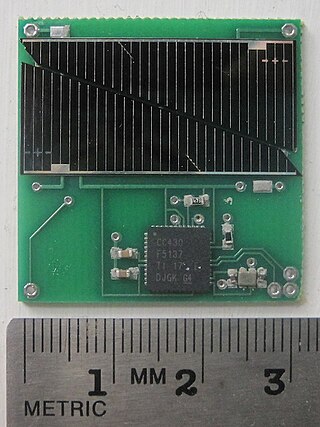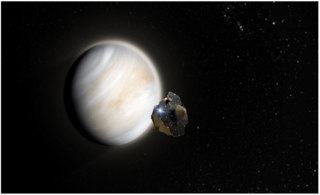
Cascade, Smallsat and Ionospheric Polar Explorer (CASSIOPE), is a Canadian Space Agency (CSA) multi-mission satellite operated by the University of Calgary. The mission development and operations from launch to February 2018 was funded through CSA and the Technology Partnerships Canada program. In February, 2018 CASSIOPE became part of the European Space Agency's Swarm constellation through the Third Party Mission Program, known as Swarm Echo, or Swarm-E. It was launched September 29, 2013, on the first flight of the SpaceX Falcon 9 v1.1 launch vehicle. CASSIOPE is the first Canadian hybrid satellite to carry a dual mission in the fields of telecommunications and scientific research. The main objectives are to gather information to better understand the science of space weather, while verifying high-speed communications concepts through the use of advanced space technologies.

A small satellite, miniaturized satellite, or smallsat is a satellite of low mass and size, usually under 1,200 kg (2,600 lb). While all such satellites can be referred to as "small", different classifications are used to categorize them based on mass. Satellites can be built small to reduce the large economic cost of launch vehicles and the costs associated with construction. Miniature satellites, especially in large numbers, may be more useful than fewer, larger ones for some purposes – for example, gathering of scientific data and radio relay. Technical challenges in the construction of small satellites may include the lack of sufficient power storage or of room for a propulsion system.

Spaceflight began in the 20th century following theoretical and practical breakthroughs by Konstantin Tsiolkovsky, Robert H. Goddard, and Hermann Oberth, each of whom published works proposing rockets as the means for spaceflight. The first successful large-scale rocket programs were initiated in Nazi Germany by Wernher von Braun. The Soviet Union took the lead in the post-war Space Race, launching the first satellite, the first animal, the first human and the first woman into orbit. The United States would then land the first men on the Moon in 1969. Through the late 20th century, France, the United Kingdom, Japan, and China were also working on projects to reach space.

This article lists all active and upcoming orbital launch systems. For retired launch vehicles, see Comparison of retired orbital launch systems.

Rocket Lab USA, Inc. is a publicly traded aerospace manufacturer and launch service provider that operates and launches lightweight Electron orbital rockets used to provide dedicated launch services for small satellites as well as a suborbital variant of Electron called HASTE. The company plans to build a larger Neutron rocket as early as 2025. Electron rockets have launched to orbit 46 times from either Rocket Lab's Launch Complex 1 in New Zealand or at the Mid-Atlantic Regional Spaceport in Wallops Island, Virginia, United States. Rocket Lab has launched one sub-orbital HASTE rocket to date from Wallops Island, Virginia. In addition to the Electron, Neutron, and HASTE launch vehicles, Rocket Lab manufactures and operates spacecraft and is a supplier of satellite components including star trackers, reaction wheels, solar cells and arrays, satellite radios, separation systems, as well as flight and ground software.

A space tug is a type of spacecraft used to transfer spaceborne cargo from one orbit to another orbit with different energy characteristics. The term can include expendable upper stages or spacecraft that are not necessarily a part of their launch vehicle. However, it can also refer to a spacecraft that transports payload already in space to another location in outer space, such as in the Space Transportation System concept. An example would be moving a spacecraft from a low Earth orbit (LEO) to a higher-energy orbit like a geostationary transfer orbit, a lunar transfer, or an escape trajectory.
The EELV Secondary Payload Adapter (ESPA) is an adapter for launching secondary payloads on orbital launch vehicles.

LauncherOne was a two-stage orbital launch vehicle developed and flown by Virgin Orbit that had operational flights from 2021 to 2023, after being in development from 2007 to 2020. It was an air-launched rocket, designed to carry smallsat payloads of up to 300 kg (660 lb) into Sun-synchronous orbit (SSO), following air launch from a carrier aircraft at high altitude. The rocket was carried to the upper atmosphere on a modified Boeing 747-400, named Cosmic Girl, and released over ocean. Initial work on the program was done by Virgin Galactic, another Virgin Group subsidiary, before a separate entity — Virgin Orbit — was formed in 2017 to complete development and operate the launch service provider business separately from the passenger-carrying Virgin Galactic business.

Secondary payload, also known as rideshare payload, is a smaller-sized payload transported to orbit on a launch vehicle that is mostly paid for—and with the date and time of launch and the orbital trajectory determined—by the entity that contracts and pays for the primary launch. As a result, the secondary payload typically obtains a substantially reduced price for transportation services to orbit, by accepting a trade off of the loss of control once the contract is signed and the payload is delivered to the launch vehicle supplier for integration to the launch vehicle. These tradeoffs typically include having little or no control over the launch date/time, the final orbital parameters, or the ability to halt the launch and remove the payload should a payload failure occur during ground processing prior to launch, as the primary payload typically purchases all of these launch property rights via contract with the launch services provider.

Firefly Aerospace is an American private aerospace firm based in Cedar Park, Texas, that develops launch vehicles for commercial launches to orbit. The company completed its $75 million Series A investment round in May 2021, which was led by DADA Holdings. The current company was formed when the assets of the former company Firefly Space Systems were acquired by EOS Launcher in March 2017, which was then renamed Firefly Aerospace. Firefly's stated purpose is to increase access to space, similar to other private spaceflight companies.

Electron is a two-stage, partially reusable orbital launch vehicle developed by Rocket Lab, an American aerospace company with a wholly owned New Zealand subsidiary. Electron was developed to service the commercial small satellite launch market. As of May 2024, it’s the third most launched small-lift launch vehicle in history. Its Rutherford engines are the first electric-pump-fed engine to power an orbital-class rocket. Electron is often flown with a kickstage or Rocket Lab's Photon spacecraft. Although the rocket was designed to be expendable, Rocket Lab has recovered the first stage twice and is working towards the capability of reusing the booster. The Flight 26 (F26) booster has featured the first helicopter catch recovery attempt.
ICEYE Ltd. is a Finnish microsatellite manufacturer. ICEYE was founded in 2014 as a spin-off of Aalto University's University Radio Technology Department, and is based in Espoo.
Curie is a liquid-propellant rocket engine designed and manufactured by Rocket Lab. A bipropellant is used for the propulsion of the third stage/kick stage of the Electron rocket, as well as the Photon. The composition of the propellant is a trade secret.

CAPSTONE is a lunar orbiter that is testing and verifying the calculated orbital stability planned for the Lunar Gateway space station. The spacecraft is a 12-unit CubeSat that is also testing a navigation system that is measuring its position relative to NASA's Lunar Reconnaissance Orbiter (LRO) without relying on ground stations. It was launched on 28 June 2022, arrived in lunar orbit on 14 November 2022, and was scheduled to orbit for six months. On 18 May 2023, it completed its primary mission to orbit in the near-rectilinear halo orbit for six months, but will stay on this orbit, continuing to perform experiments during an enhanced mission phase.

Varda Space Industries is a privately held American space research company headquartered in El Segundo, California. Founded in November 2020, the company designs, builds, and flies spacecraft that manufacture materials in microgravity. The company targets in-space manufacturing of materials that are difficult to produce in Earth's gravity, and brings those materials back to Earth with their atmospheric reentry vehicle. Investors in the company include venture capitalists such as Khosla Ventures and Peter Thiel's Founders Fund.

Small Innovative Missions for Planetary Exploration (SIMPLEx) is a planetary exploration program operated by NASA. The program funds small, low-cost spacecraft for stand-alone planetary exploration missions. These spacecraft are intended to launch as secondary payloads on other missions and are riskier than Discovery or New Frontiers missions.
Escape and Plasma Acceleration and Dynamics Explorers (EscaPADE) is a planned spacecraft mission to Mars consisting of two spacecraft known as Blue and Gold. The mission, expected to launch in September 2024, is part of NASA's SIMPLEx program. In May 2024, it was announced the spacecraft reached substantial completion.

Venus Life Finder is a planned uncrewed spacecraft to Venus designed to detect signs of life in the Venusian atmosphere. The first private Venus mission, the spacecraft is being developed by Rocket Lab in collaboration with a team from the Massachusetts Institute of Technology. The spacecraft will consist of a Photon Explorer cruise stage which will send a small atmospheric probe into Venus with a single instrument, an autofluorescing nephelometer, to search for organic compounds within Venus' atmosphere.














